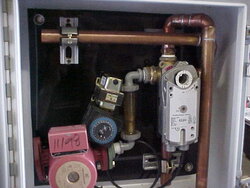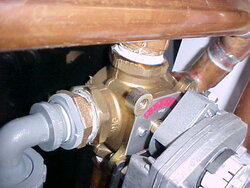Hi folks,
I am helping out my neighbor on a project. He doing a major remodel of his house and he wants a wood boiler and thermal storage. The house heat will be mostly staple up radiant. There is no room for an indoor tank, but we were thinking about sinking one in the ground in his crawl space (new construction).
First ideas were either field fabricated concrete, or prefab. A 1000 gallon precast "septic" tank is about $1000 delivered. (they will drop it in a hole @ delivery). Then it has to be insulated and needs some heat-x coils.
I just spoke with STSS. They recomend 2- 180 ft 3/4" coils, plus a DHW preheat coil. The 180 ft coils are $735 ea, and the dhw coil is $432. (ouch). I am getting a price on copper, but I dont think that I can beat that price.
Next, I have to figure out how to control it. Usually I build control panels with a Tekmar controller. Tekmar makes a "solar storage" control, but its $700. STSS uses an EMC control, for about $160 which thay claim can be integrated to another system. I am getting info on it and will check it out.
BUT, in general how are these things controlled? I can envision a 3 way valve on the primary loop, either diverting the water thru the heat-x coils, or bypassing. Is this too simplistic? Do I need to MIX or will on/off be good enough. Also, Sven @ STSS mentioned that in "their" design , they charge from the top, and discharge from the bottom to facilitate stratification. Is this necessary?
Attached is the proposed system design.
Thanks for your help.
I am helping out my neighbor on a project. He doing a major remodel of his house and he wants a wood boiler and thermal storage. The house heat will be mostly staple up radiant. There is no room for an indoor tank, but we were thinking about sinking one in the ground in his crawl space (new construction).
First ideas were either field fabricated concrete, or prefab. A 1000 gallon precast "septic" tank is about $1000 delivered. (they will drop it in a hole @ delivery). Then it has to be insulated and needs some heat-x coils.
I just spoke with STSS. They recomend 2- 180 ft 3/4" coils, plus a DHW preheat coil. The 180 ft coils are $735 ea, and the dhw coil is $432. (ouch). I am getting a price on copper, but I dont think that I can beat that price.
Next, I have to figure out how to control it. Usually I build control panels with a Tekmar controller. Tekmar makes a "solar storage" control, but its $700. STSS uses an EMC control, for about $160 which thay claim can be integrated to another system. I am getting info on it and will check it out.
BUT, in general how are these things controlled? I can envision a 3 way valve on the primary loop, either diverting the water thru the heat-x coils, or bypassing. Is this too simplistic? Do I need to MIX or will on/off be good enough. Also, Sven @ STSS mentioned that in "their" design , they charge from the top, and discharge from the bottom to facilitate stratification. Is this necessary?
Attached is the proposed system design.
Thanks for your help.


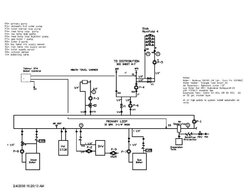
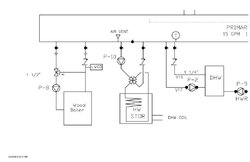
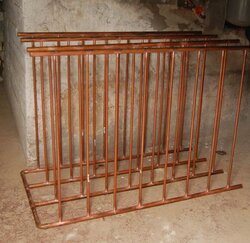
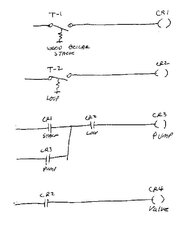
 Every 15 minutes the flow changes direction to try to warm the loop from both ends. I tested it in my shop, data logged it on some 800 foot loops.
Every 15 minutes the flow changes direction to try to warm the loop from both ends. I tested it in my shop, data logged it on some 800 foot loops.